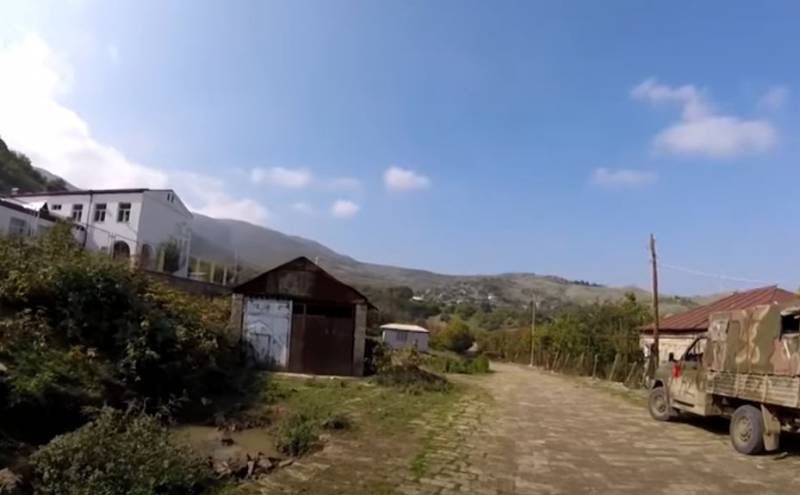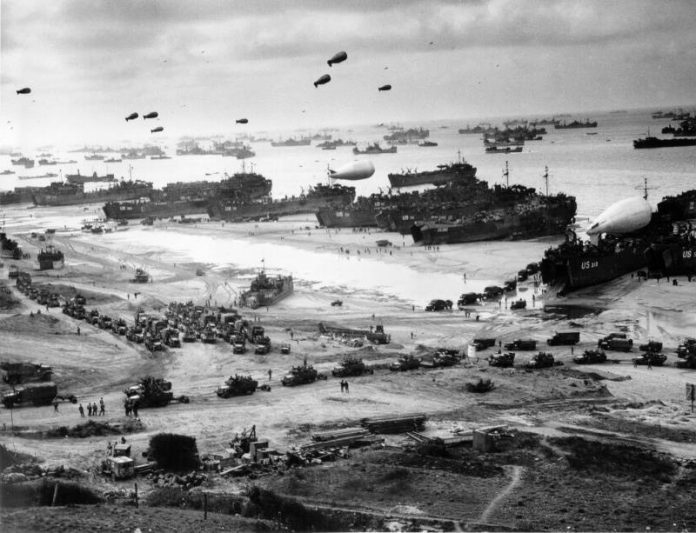 Panoramic view of Omaha Beach. Allied troops unload equipment and cargo to the captured and already "equipped" bridgehead. American 2nd Armored Division - 1st Panzer Division lands, landed in Normandy.
Panoramic view of Omaha Beach. Allied troops unload equipment and cargo to the captured and already "equipped" bridgehead. American 2nd Armored Division - 1st Panzer Division lands, landed in Normandy.
75 years ago a second front was opened. Allied U.S. Forces, England and Canada landed in French Normandy. The Normandy operation is still the largest amphibious operation in the history of mankind - more than 3 million. human. The Third Reich in Europe had to fight on two fronts.
The masters of the West were waiting, when will the mutual destruction of the forces of Germany and the USSR take place
AT 1943 year there was a real opportunity for the approach of victory in the German bloc. If the Anglo-Americans opened a second front in Western Europe in 1943 city, the, obviously, that World War II would have ended earlier, how it really happened. And with all the ensuing consequences: less human losses, material destruction, etc.. d.
The United States and Britain already possessed everything necessary for the success of a strategic amphibious operation in Europe.. AT 1943 g. only US military production in 1,5 times the military production in the Third Reich, Italy and Japan, together. States only in 1943 produced about 86 thousand. aircraft, about 30 thousand. tanks and 16,7 thousand. guns. England also ramped up military production. The Anglo-Saxons were powerful enough, to start fighting in Europe.
Great Britain, along with the dominions, had in its armed forces 4,4 million. human (not to mention 480 thousand. human colonial and dominion troops, who were busy with internal defense). US Army and Navy at the end 1943 years counted 10,1 million. human. At the same time, the allies had a huge fleet and built a large number of transports for transporting troops., weapons and equipment. Only in 1943 g. americans built 17 thousand. landing ships, ships and barges.
In this way, The United States and England had such military power, far outnumbered by the forces of the German bloc. However, most of these forces and resources were inactive.. London and Washington were still waiting, while in Russian (East) a gigantic battle continued on the front. Allied strategy, as before, was reduced to dispersing forces on secondary fronts and directions.
However, in the second half 1943 - early 1944 year it became clear, what the red empire takes up. Hitler's Reich is exhausted, loses the war of attrition and retreats. The collapse of Germany became apparent. There was a risk, that the Soviet army in its victorious offensive will liberate most of Europe, and it will enter the sphere of influence of Moscow. It was impossible to delay any longer. The Russians won the war without a second front.
In January 1943 of the year in the North African port of Casablanca, a regular meeting of the military-political leadership of the United States and England took place. U.S. Army Chief of Staff Marshall, who opposed the “floundering” strategy in the Mediterranean, proposed in 1943 g. invade France across the English Channel. US Navy Chief of Staff King and US Air Force Chief of Staff Arnold did not support the idea..
Roosevelt also did not support Marshall, the American president was inclined to support the point of view of the British delegation on the expansion of hostilities in the Mediterranean. The British were unanimous in the strategy of the war: complete operations in North Africa first, take over Sicily, create conditions for landing in Italy and the Balkans. The British hoped, that a strategic offensive from the south would cut off the Russians from the center of Europe.
Westerners in the beginning 1943 g. We have seen, that the Soviet Union has the necessary power, to crush the Reich. But it was still unknown, how long will it take for Russians, to knock the Germans out of the Union, and then transfer the hostilities to the territory of the satellites of Germany and the countries and peoples enslaved by the Nazis. The hosts of London and Washington were still waiting, that there will be a mutual destruction of the forces of Germany and Russia, exsanguination of Germans and Russians. After this, the Anglo-American troops, preserved their strength, easily put Europe under control.
Soviet Union, exhausted in terrible carnage, had to cede world domination to the Anglo-American bloc. earlier, in 1941-1942., the masters of the USA and England believed, that the Soviet colossus on feet of clay will fall under the onslaught of Hitler's "blond beasts". However, the Third Reich will be weakened by resistance in the East, and it can be neutralized, find a common language with the German elite. Therefore, the masters of the West in 1939 - early 1941 g. made Hitler understand, that there will be no second front, that the Wehrmacht can safely fight on the Eastern Front. Then it was possible to eliminate with the help of the generals of the obstinate and much-imagined Fuhrer, put a more convenient figure at the head of the Third Reich and blame Hitler for all the mistakes and crimes.
In this way, the masters of the USA and England refused to open a second front in the period 1942-1943., so that Germany and the USSR were drained of blood as much as possible in the battle of the titans. The Anglo-Saxons were going to finish off the winner and establish their own world order. When it became obvious, what the Russians take up, Westerners proceeded from the fact, that the USSR will for a considerable time be shackled in a one-on-one struggle with the losing, but still strong Germany.
The United States and England at this time will create an overwhelming military-economic advantage and will enter the game at the most favorable moment, so that the USSR could not act as the liberator of the countries and peoples of Europe. Russians will break the Germans by now, and the Anglo-American troops will be able to safely land in France and reach Berlin without any problems.
At the same time, the USA and England, although the goal was common, there were discrepancies in military strategy. Churchill was more interested in t. n. Balkan question. British prime minister considered, that bases in North Africa, Sicily and Sardinia (after their capture) must be used not only for the liberation of Italy, but also for the offensive in the Balkan Peninsula. Churchill believed, that such a strategy would provide the United States and England with dominance in Southern and Southeast Europe, and then in Central Europe. However, the rapid advance of the Red Army thwarted the plans to create a second front of the United States and Britain in the Balkans.
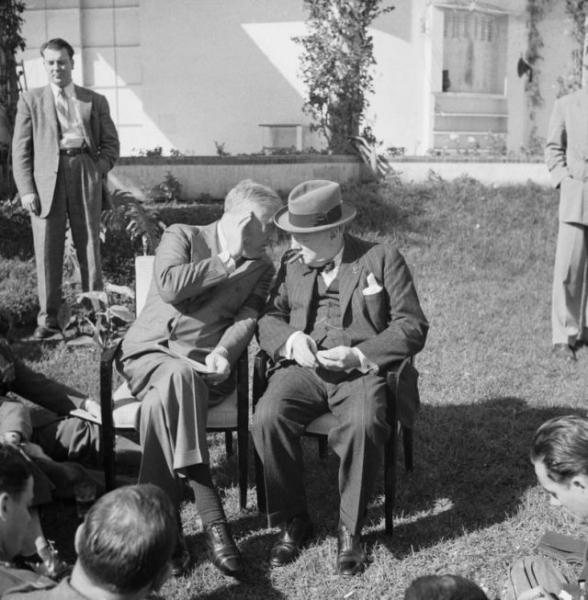 Franklin D. Roosevelt and Winston Churchill at the Casablanca Conference. January 1943 of the year
Franklin D. Roosevelt and Winston Churchill at the Casablanca Conference. January 1943 of the year
The decision to open a second front
Informing Moscow about the results of the Casablanca meeting, Westerners reported, that they are preparing a landing operation in France in August 1943 of the year. But in May, 1943 years at a conference in Washington, the leaders of the United States and England postponed the date of the invasion of France by 1944 year. An agreement was also reached on joint bombing of the Third Reich.. The Anglo-Saxons continued to focus on offensive operations in the Mediterranean and Pacific theaters.
Stalin was informed about it. The Soviet leader, in his reply to Roosevelt, noted: «This decision of yours creates exceptional difficulties for the Soviet Union., for two years already waging a war with the main forces of Germany and its satellites with extreme exertion of all their forces... "Even more harshly Stalin, in his message to Churchill, noted the disappointment of the Soviet government and the decline in confidence in the allies.
Major victories 1943 years of the Red Army on the Eastern Front (strategic turning point in the war) forced the leaders of the United States and Britain to intensify efforts to open a second front. In these conditions, Roosevelt inclined in favor of the landing of troops in France.. Balkan version, which the British prime minister insisted on, no longer met with American support. At the US-UK Quebec Conference in August 1943 it was decided, that the invasion of Northwest Europe will begin 1 May 1944 of the year. Roosevelt curled, that the allies must reach Berlin no later than the Russians. The Allies focused on preparing for an invasion across the English Channel.
At the Tehran Conference (28 November - 1 December 1943 of the year) the Soviet delegation headed by Stalin insisted on the exact date for the opening of the second front - 1 May 1944 g. Churchill, under the guise of speculation about the conduct of hostilities in the Mediterranean theater, did not want to give such a guarantee., speaking, that the operation may have to be postponed for 2-3 months.
At the meeting 29 November, the Soviet leader raised this issue again, speaking, that it would be nice to carry out an amphibious operation within May, 10-May 20. At this time, the weather conditions are most favorable.. Stalin called Allied operations in the Mediterranean "sabotage". American President Roosevelt did not support Churchill in his desire to postpone the invasion of France.
At the meeting 30 November, the Anglo-American side confirmed, that the landing of the allied forces will be carried out during May. Stalin reported, that at the same time Soviet troops would launch a powerful offensive on the Eastern Front, to deprive the Wehrmacht of the opportunity to transfer reinforcements from East to West. In this way, at the Tehran conference, the landing plan in France was confirmed.
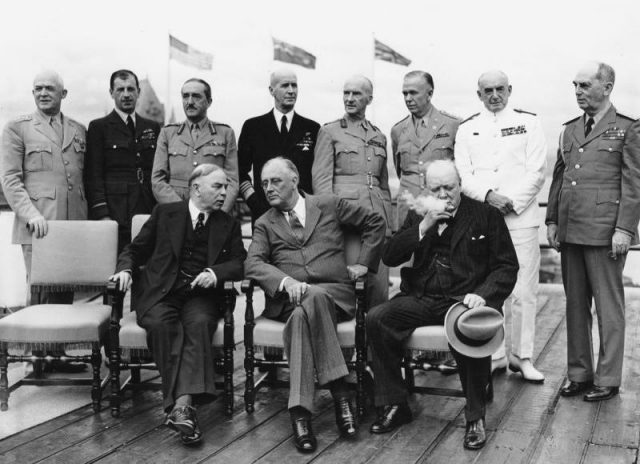 Mackenzie King, Roosevelt, Churchill and the High Command of the US and British Forces during the Quebec Conference. From left to right: 1) seated: William Mackenzie King (Prime Minister of Canada), Franklin Delano Roosevelt (President of the U.S.A), Winston Churchill (British Prime Minister); 2) standing: General Henry Arnold (USA), Air Chief Marshal Charles Portal (United Kingdom), General Alan Brook (United Kingdom), Admiral Ernst King (USA), Field Marshal John Dill (United Kingdom), General George Marshall (USA), Admiral Dudley Pound (United Kingdom) and Admiral William Lehey (USA). November 1943 g.
Mackenzie King, Roosevelt, Churchill and the High Command of the US and British Forces during the Quebec Conference. From left to right: 1) seated: William Mackenzie King (Prime Minister of Canada), Franklin Delano Roosevelt (President of the U.S.A), Winston Churchill (British Prime Minister); 2) standing: General Henry Arnold (USA), Air Chief Marshal Charles Portal (United Kingdom), General Alan Brook (United Kingdom), Admiral Ernst King (USA), Field Marshal John Dill (United Kingdom), General George Marshall (USA), Admiral Dudley Pound (United Kingdom) and Admiral William Lehey (USA). November 1943 g.
On the eve of landing in Normandy
During the winter and spring campaign 1944 years the Red Army inflicted a heavy defeat on the Wehrmacht. Soviet troops conducted a series of brilliant strategic offensive operations. During the first "Stalinist strikes", our troops finally unblocked Leningrad, liberated Novgorod, Right-bank Ukraine and Crimea. The Red Army reached the state border of the USSR and the Balkans. Black Sea Fleet, returning its main base in Sevastopol and Odessa, gained dominance in the Black Sea. The military-political positions of the Germans in Romania are under threat, Bulgaria and Hungary. Soviet troops occupied convenient bridgeheads for a further offensive in the northern, central and southern strategic directions.
The problem of opening a second front in Europe has become 1944 g. largely different content, than in 1942-1943. They used to wait in London and Washington, when the Russians and the Germans kill each other, then it was possible to calmly "clean up" the remnants of the forces of the Third Reich or the Union, having received absolute power on the planet. However, a radical change in the course of World War II (Stalingrad and the Battle of Kursk) showed, that great Russia (the USSR) capable of finishing off Hitler's Germany alone. That is, on the planet, the Anglo-Saxons still had a geopolitical enemy - the Russians. It radically changed the situation.
The Anglo-Saxons could no longer delay the opening of a second front in Europe. Further delay threatened with big problems. Russians could liberate not only Central and Southeastern Europe, but go further. Occupy all of Germany and part of France. Therefore, in January 1944 year begins preparations for the invasion of the Allied forces in Northern France and an auxiliary operation in Southern France. Headquarters of the Supreme Commander of the Allied Armed Forces in England 15 January was transformed into the Supreme Headquarters of the Allied Expeditionary Forces. US General Eisenhower appointed Supreme Commander of the Allied Forces.
11 February 1943 year, the Joint Chiefs of Staff approved Eisenhower's directive, that the main task of the allied forces is, to invade Europe and defeat Germany. The invasion was scheduled for May 1944 of the year. The allies received information that, that the Germans created the most solid defense on the Pas-de-Calais coast. therefore, despite the advantage of this site (English Channel is much wider than Pas-de-Calais, and the coast, due to the limited ports and rough terrain in the depths, is inconvenient for an amphibious operation), it was decided to attack across the English Channel - in Normandy.
The Allies planned to seize vast territory in Normandy and the Brittany Peninsula with the help of amphibious assault. After the accumulation of significant funds and forces to break through the defenses of the Nazis and in two groups to reach the border of the Seine and Loire, and then to the border of the Reich. The main blow was planned on the left wing, to seize ports and threaten the Ruhr, Germany's main industrial center. On the right wing, the allies were to join up with the troops, who will land in France in the south.
During the next stage of the offensive, the Anglo-American troops were to defeat the Germans west of the Rhine and take bridgeheads on its eastern bank to continue operations to completely defeat Nazi Germany..
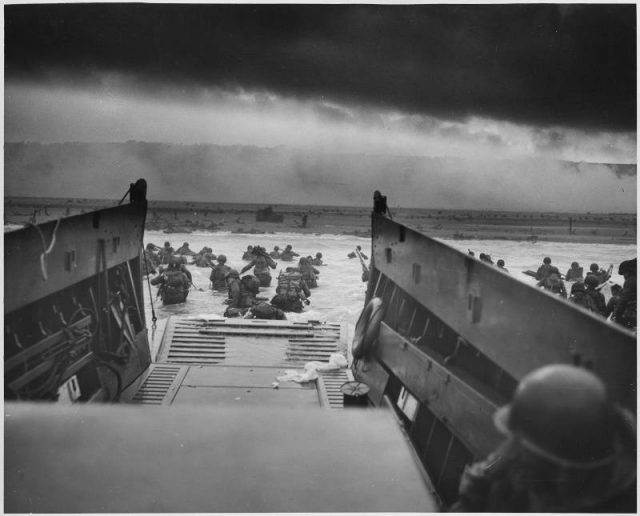 The beginning of the landing of units of Company E, 16th Infantry Regiment, 1st Infantry Division, US Army on Omaha Beach. Photo source: http://waralbum.ru
The beginning of the landing of units of Company E, 16th Infantry Regiment, 1st Infantry Division, US Army on Omaha Beach. Photo source: http://waralbum.ru
In preparation for the operation, the allies concentrated in Britain 4 army: 1-me and 3rd American, 2-I am English and 1st Canadian. Their composition was 37 divisions (including 10 armored and 4 airborne) and 12 crews. For the landing operation, 1213 warships, over 4100 landing craft, barges and boats, about 1600 merchant and auxiliary vessels.
Allied air forces numbered over 10200 combat and 1360 transport aircraft, 3500 gliders. The allies also had a strategic air force (8-i am the american air force and british strategic aviation), who, in preparation for the invasion of France, attacked German military installations and cities. First of all, the Allies sought to destroy airfields and aircraft factories of the Reich, its transport and energy infrastructure.
April-May 1944 of the year Anglo-American aviation concentrated bombing railways and airfields in Belgium and France, to reduce the ability of the Wehrmacht to maneuver forces and reserves.
To be continued…
/Alexander Samsonov, topwar.ru/








